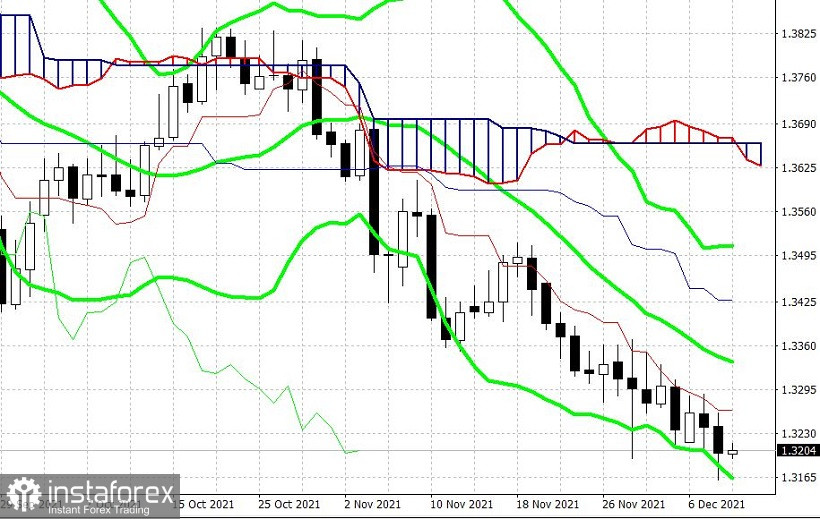Yesterday, the GBP/USD pair updated another price low of the year. It is noteworthy that the pound's value declined even against the background of the uncertain positions of the US currency. After a temporary growth, the dollar index fell into depression again, reflecting weak demand for the US dollar. Nevertheless, the GBP/USD pair showed an impulsive 100-point decline yesterday, primarily due to the devaluation of the British currency.
Among all the fundamental reasons, two should be distinguished: coronavirus and Brexit. Negative information flow puts significant pressure on the pound. The situation is not saved even by the Bank of England, whose representatives have recently voiced rather hawkish theses. But, apparently, the market is skeptical about such statements, amid the worsening epidemiological situation in the UK and the aggravation of the trade and political conflict with the European Union.

Omicron strain broke into the currency market rapidly, establishing its own "orders" and rules of the game. However, these "rules" have changed over time. If in the first days of December, classic protective instruments (franc, yen) were in favor, but now, the situation is somewhat different. In general, the market approaches the issue of the spread of coronavirus in its own way, and this approach is quite pragmatic. Traders are primarily concerned about the reaction of the authorities and the possible economic consequences of the next wave of the epidemic in the context of new lockdowns. The very fact of an increase in the number of infected people sometimes does not bother investors, no matter how cynical it may sound.
For example, a new strain of coronavirus has already spread to almost 60 countries around the world. The authorities of these countries react differently to the current situation: basically, they are limited to closing borders and strengthening quarantine control. However, the UK decided to play ahead of the curve by activating the so-called "plan B". Starting next week, citizens of the country will be obliged to resume the remote format of work. In addition, the wearing of masks will become mandatory in public places (for example, in theaters and cinemas) from December 10. And a week later, COVID-19 passports will be introduced, which will give carriers the right to attend nightclubs, concerts, and other public events. The head of the British government, Boris Johnson, said that quarantine restrictions will be lifted "as soon as it becomes clear that the revaccination campaign helps to overcome the new version of the coronavirus." At the same time, he added that Omicron is spreading in the country much faster than Delta.
Meanwhile, the first laboratory studies of the new strain suggest that it is no more dangerous than other variants of Covid, although it may partially bypass the protection offered by existing coronavirus vaccines. But still, scientists are inclined to believe that the drugs used protect vaccinated people from the severe course of the disease and from death. Also, experts came to the conclusion that booster doses can provide good protection from Omicron.
But in the context of the GBP/USD pair, these encouraging and even optimistic conclusions of experts do not work. Traders are guided primarily by the British government, which has decided to strengthen quarantine restrictions.
Another factor of uncertainty is Brexit. It can be recalled that the conflict between London and Paris over fishing issues has become particularly acute in recent weeks. To date, the situation remains paralyzed. This week, the British press reported that London is ready to offer the French a "path to reconciliation." An additional agreement may be reached between the countries, which will allow issuing more licenses to French (and generally European) fishermen. But, firstly, there is no official information about this, and secondly, the British vision of conflict resolution, as a rule, does not coincide with the French one. Therefore, it is too early to remove this issue from the agenda. In general, the British-French conflict has become another irritating factor in the tension between London and Brussels over the Northern Ireland Protocol - part of the Brexit agreement concerning Northern Ireland.
Thus, the prevailing fundamental background contributes to a further decline in the pair. According to several experts, the "Omicron factor" will force the Bank of England to postpone the decision to raise interest rates for next year, although many members of the British regulator were recently ready to take the first step in this direction in December. Even Mike Saunders, who spoke last month about the risks of "delaying the rate hike for too long," said this week that he would like to get more information about the new strain before making a decision.
According to a survey conducted by Reuters, most economists doubt that the rate will be raised at the December meeting. Whereas back in November, they were sure that this would happen at the last meeting of the members of the regulator this year.

From the point of view of technical analysis, the pair on the D1 timeframe is located between the middle and lower lines of the Bollinger Bands indicator, as well as under all the lines of the Ichimoku indicator, which shows a bearish "Line Parade" signal. All these signals of a technical nature also indicate the priority of the downward movement. The first, and so far the main downward target is located at 1.3160 - this is the price low of the year, coinciding with the lower line of the Bollinger Bands on the daily chart. If the GBP/USD bears consolidate below this target, they will open their way to the base of the 31st mark.





















